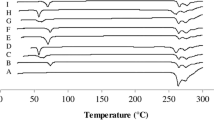Abstract
The present study was performed to design oral controlled delivery systems for the water-soluble drug, verapamil hydrochloride, using natural and semisynthetic polymers as carriers in the forms of 1- and 3-layer matrix tablets. Verapamil hydrochloride 1-layer matrix tablets containing hydroxypropylmethylcellulose, tragacanth, and acacia either alone or mixed were prepared by direct compression technique. 3-layer matrix tablets were prepared by compressing the polymers as release retardant layers on both sides of the core containing the drug. The prepared tablets were subjected to in vitro drug release studies. Tragacanth when used as the carrier in the formulation of 1- and 3-layer matrices produced satisfactory release prolongation either alone or in combination with the other 2 polymers. On the other hand, acacia did not show enough prolonging efficiency in 1- and 3-layer matrix tablets. The results also showed that the location of the polymers in the 3-layer tablets has a pronounced effect on the drug release. Kinetic analysis of drug release from matrices exhibiting sustained release indicated that release was predominantly attributable to the contribution made by Fickian diffusion, while the erosion/relaxation mechanisms had a minor role in the release.
Similar content being viewed by others
References
Peppas NA.Hydrogels in Medicine and Pharmacy. Vols 1–3. Boca Raton, FL: CRC Press; 1998.
Conte U, Maggi L, Colombo P, La Manna A. Multilayered hydrophilic matrices as constant release devices (Geomatrix Systems).J Control Release. 1993;26:39–47.
Narasimhan B, Langer R. Zero-order release of micro- and macromolecules from polymeric devices: the role of burst effect.J Control Release. 1997;47:13–20.
Lee ES, Kim SW, Kim SH, Cardinal JR, Jacobs H. Drug release from hydrogel devices with rate-controlling barriers.J Membr Sci. 1980;7:293–303.
Bodmeier R, Paeratakul O. Drug release from laminated polymeric films prepared from aqueous latexes.J Pharm Sci. 1990;79:32–36.
Krishnaiah YS, Karthikeyan RS, Gouri Sankar V, Satyanarayana V. Three-layer guar gum matrix tablet formulations for oral controlled delivery of highly soluble trimetazidine dihydrochloride.J Control Release. 2002;81:45–56.
Wade A, Weller PJ.Handbook of Pharmaceutical Excipients. London, UK: The Pharmaceutical Press; 1994.
Khan KA. Concept of dissolution efficiency.J Pharm Pharmacol. 1975;27:48–49.
Peppas NA, Sahlin JJ. A simple equation for the description of solute release. 3. Coupling of diffusion and relaxation.Int J Pharm. 1989; 57:169–172.
Chukwu KI, Udeala OK. Binding effectiveness of Colocasia esculenta gum in poorly compressible drugs-paracetamol and metronidazole tablet formulations.Boll Chim Farm. 2000;139:89–97.
Bhardwaj TR, Kanwar M, Lal R, Gupta A. Natural gums and modified natural gums as sustained release carriers.Drug Dev Ind Pharm. 2000;26:1025–1038.
Meshali MM, Gabr KE. Effect of interpolymer complex formation of chitosan with pectin or acacia on the release behavior of chlorpromazine HCl.Int J Pharm. 1993;89:177–181.
Johnston D, Gray MR, Reed CS, Bonner FW, Anderson NH. Comparative evaluation of 5 common suspending agents used in drug safety studies.Drug Dev Ind Pharm. 1990;16:1893–1909.
Chukwu A. Studies on Detarium microcarpium gum. 2. Investigation as a prolonged release matrix for encapsulated chlorpheniramine maleate.STP Pharma Sci. 1994;4:399–403.
Chukwu A. Studies on Detarium microcarpium gum. 3. In vitro characteristics of prolonged release chlorpheniramine maleate tablets.STP Pharma Sci. 1994;4:404–408.
Berens AR, Hopfenberg HB. Diffusion and relaxation in glassy polymer powders. 2. Separation of diffusion and relaxation parameters.Polymers. 1978;19:489–497.
Pham AT, Lee PI. Probing the mechanism of drug release from hydroxypropylmethyl cellulose matrices.Pharm Res. 1994;11:1379–1384.
Durig T, Fassihi R. Guar-based monolithic matrix systems: effect of ionizable and non-ionizable substances and excipients on gel dynamics and release kinetics.J Control Release. 2002;80:45–56.
Pillay V, Fassihi R. A novel approach for constant rate delivery of highly soluble bioactives from a simple monolithic system.J Control Release. 2000;67:67–78.
Author information
Authors and Affiliations
Corresponding author
Additional information
Published: December 7, 2005
Rights and permissions
About this article
Cite this article
Siahi, M.R., Barzegar-Jalali, M., Monajjemzadeh, F. et al. Design and evaluation of 1- and 3-layer matrices of verapamil hydrochloride for sustaining its release. AAPS PharmSciTech 6, 77 (2005). https://doi.org/10.1208/pt060477
Received:
Accepted:
DOI: https://doi.org/10.1208/pt060477




